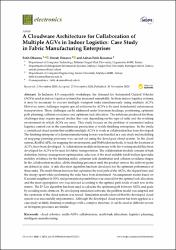| dc.contributor.author | Okumuş, Fatih | |
| dc.contributor.author | Dönmez, Emrah | |
| dc.contributor.author | Kocamaz, Adnan Fatih | |
| dc.date.accessioned | 2021-06-04T12:17:12Z | |
| dc.date.available | 2021-06-04T12:17:12Z | |
| dc.date.issued | 2020 | en_US |
| dc.identifier.citation | Fatih Okumuş, Emrah Dönmez, & Adnan Fatih Kocamaz. (January 01, 2020). A Cloudware Architecture for Collaboration of Multiple AGVs in Indoor Logistics: Case Study in Fabric Manufacturing Enterprises. Electronics, 9, 2023.) | en_US |
| dc.identifier.issn | 2079-9292 | |
| dc.identifier.uri | https://doi.org/10.3390/electronics9122023 | |
| dc.identifier.uri | https://hdl.handle.net/20.500.12899/185 | |
| dc.description.abstract | In Industry 4.0 compatible workshops, the demand for Automated Guided Vehicles (AGVs) used in indoor logistics systems has increased remarkably. In these indoor logistics systems, it may be necessary to execute multiple transport tasks simultaneously using multiple AGVs. However, some challenges require special solutions for AGVs to be used in industrial autonomous transportation. These challenges can be addressed under four main headings: positioning, optimum path planning, collision avoidance and optimum task allocation. The solutions produced for these challenges may require special studies that vary depending on the type of tasks and the working environment in which AGVs are used. This study focuses on the problem of automated indoor logistics carried out in the simultaneous production of textile finishing enterprises. In the study, a centralized cloud system that enables multiple AGVs to work in collaboration has been developed. The finishing enterprise of a denim manufacturing factory was handled as a case study and modelling of mapping-planning processes was carried out using the developed cloud system. In the cloud system, RestFul APIs, for mapping the environment, and WebSocket methods, to track the locations of AGVs, have been developed. A collaboration module in harmony with the working model has been developed for AGVs to be used for fabric transportation. The collaboration module consists of task definition, battery management-optimization, selection of the most suitable batch trolleys (provides mobility of fabrics for the finishing mills), optimum task distribution and collision avoidance stages. In the collaboration module, all the finishing processes until the product arrives the delivery point are defined as tasks. A task allocation algorithm has been developed for the optimum performance of these tasks. The multi-fitness function that optimizes the total path of the AGVs, the elapsed time and the energy spent while performing the tasks have been determined. An assignment matrix based on K nearest neighbor (k-NN) and permutation possibilities was created for the optimal task allocation, and the most appropriate row was selected according to the optimal path totals of each row in the matrix. The D* Lite algorithm has been used to calculate the optimum path between AGVs and goals by avoiding static obstacles. By developing simulation software, the problem model was adapted and the operation of the cloud system was tested. Simulation results showed that the developed cloud system was successfully implemented. Although the developed cloud system has been applied as a case study in fabric finishing workshops with a complex structure, it can be used in different sectors as its logistic processes are similar. | en_US |
| dc.language.iso | eng | en_US |
| dc.publisher | Multidisciplinary Digital Publishing Institute (MDPI) | en_US |
| dc.relation.isversionof | 10.3390/electronics9122023 | en_US |
| dc.rights | info:eu-repo/semantics/openAccess | en_US |
| dc.subject | Cloud robotics | en_US |
| dc.subject | Intelligent manufacturing | en_US |
| dc.subject | Logistics planning | en_US |
| dc.subject | Multi-AGVs collaboration | en_US |
| dc.subject | Multi-task allocation | en_US |
| dc.title | A cloudware architecture for collaboration of multiple agvs in indoor logistics: Case study in fabric manufacturing enterprises | en_US |
| dc.type | article | en_US |
| dc.authorid | 0000-0003-3046-9558 | en_US |
| dc.authorid | 0000-0003-3345-8344 | en_US |
| dc.department | MTÖ Üniversitesi, Doğanşehir Vahap Küçük Meslek Yüksekokulu, Bilgisayar Teknolojileri Bölümü | en_US |
| dc.contributor.institutionauthor | Okumuş, Fatih | |
| dc.contributor.institutionauthor | Dönmez, Emrah | |
| dc.identifier.volume | 9 | en_US |
| dc.identifier.issue | 12 | en_US |
| dc.identifier.startpage | 1 | en_US |
| dc.identifier.endpage | 24 | en_US |
| dc.relation.journal | Electronics (Switzerland) | en_US |
| dc.relation.publicationcategory | Makale - Uluslararası Hakemli Dergi - Kurum Öğretim Elemanı | en_US |


















